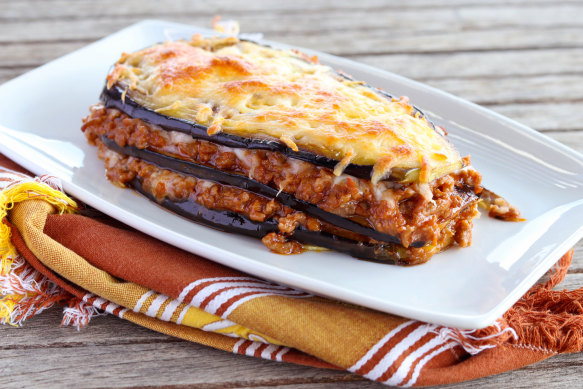Plate up
Ever get the feeling you’ve bitten off more than you can chew? That’s happening to me, right now, as I research moussaka, a dish I had thought was comfortably Greek – and in the eyes of many Greek people, it probably is – and yet it is one with a history that’s far more complex, and possibly even controversial. We’ll get to that below. This space, meanwhile, is more for a description, so let’s launch into a hearty casserole of eggplant fried in oil, layered with beef mince cooked down with tomatoes and soffritto (a mix of diced onions, carrots and celery), topped with a layer of either bechamel or savoury custard. Look for classic herbs and spices such as bay leaves, cinnamon and oregano, and the occasional introduction of a layer of potatoes. Classic, and delicious.

Moussaka – its origins aren’t as clear as it might seem.
First serve
If you thought the history of moussaka was simple and settled, you may not have been reading this column too long. So many of the world’s classic dishes have a past as murky as a miso soup, and passionately fought over. Here’s what’s commonly accepted: the dish that would go on to inspire moussaka was invented in what is now Iraq, a recipe having been found in a 13th-century text called A Baghdad Cookery Book. This eggplant-heavy dish was then introduced to the Ottoman Empire, which at that point took in Greece. After the dissolution of that empire, Greek cooks added the layer of bechamel, and the name moussaka was taken from the Arabic musaqqa’a. And we can all agree on that. Right?
Order there
If you find yourself in Athens with a hankering for moussaka, go no further than To Kati Allo, within walking distance of the Acropolis (no website).
Order here
Sydneysiders, don’t miss the moussaka at Corinthian Rotisserie Restaurant in Marrickville (no website). In Melbourne, it’s hard to go past a classic like Stalactites. Brisbane folk should try Lefkas Taverna in West End.
One more thing
That original recipe from the Baghdad cookery book would be unrecognisable to modern-day moussaka fans – it was more like an eggplant stew. The good people of Turkey tend to claim the layering idea, with the Greeks given credit for the white sauce.






